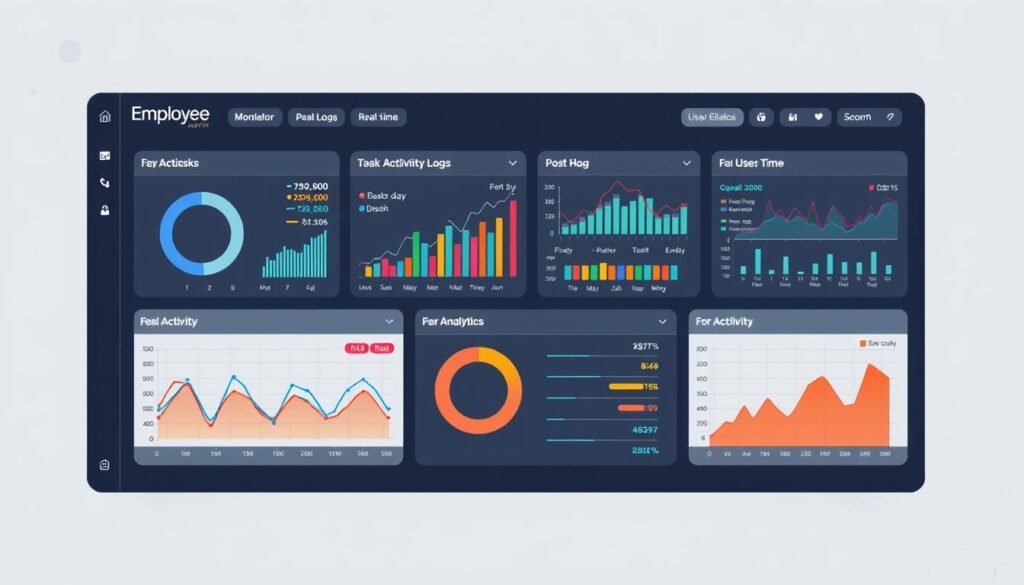Is your remote team as productive as you believe? Employee monitoring software is changing the game for businesses in the hybrid work era. With more teams spread out, tracking work hours and productivity is key.
Americans waste about 2.9 hours daily at work. This leads to a huge loss of $1.7 million a year for every 100 employees. Workforce analytics tools can help by giving insights to improve your business.
These tools track time and manage tasks, giving you the data to boost your team’s performance. Top picks like ActivTrak, Controlio, and Hubstaff have features perfect for today’s varied work settings.
Want to make your team more efficient? Let’s see how employee monitoring software can change your productivity approach and help your business succeed in the digital world.
Understanding Employee Monitoring Software
Employee surveillance is a big topic in the business world. Companies want to boost productivity and protect their assets. That’s why workplace monitoring tools are getting more popular. These tools give insights into how employees work and help improve operations.
Definition and Purpose
Employee activity monitoring software tracks and analyzes work tasks. It aims to find ways to work better, improve security, and boost performance. With 70% of American workers not fully engaged, these tools can help solve productivity issues that cost businesses $650 billion a year.
Key Features of Monitoring Tools
Modern employee surveillance systems have many features. Time tracking lets companies see how many hours employees work. Screenshot capture shows what’s on the screen. Keystroke logging records what’s typed for security. Some tools even track mobile employees, which is great for field service jobs.
Benefits for Businesses
Using these tools can really help businesses. Restaurants that use them can see revenue go up by up to 7%. These tools cut down on wasted time, since 69% of men and 62% of women use the internet for personal stuff at work. They also make data security stronger, which is important since nearly half of Americans have had their personal data stolen.
The Rise of Remote Work and Its Impact on Productivity
Remote work has changed how businesses run. Now, about 40% of workers in developed countries work from home. This shift has led to a big increase in using software to keep an eye on employees, with a 75% rise in searches in March 2020.
Companies worry a lot about how productive remote workers are. In fact, 85% of leaders find it hard to trust their team’s work from afar. So, 80% of employers now use software to check on how well employees are doing and what they’re doing online.
Tools for managing remote teams help solve these problems. They track time, manage tasks, and give real-time updates on productivity. Tools like Airtable Product Management, ProofHub, and Time Doctor are popular. They help companies set productivity standards and see how new ways of working are doing.
But, it’s important to think about what employees think. They’re worried about privacy, keeping data safe, and losing control over their work. Companies need to find a balance. They should keep an eye on productivity without hurting trust and respecting workers’ rights in the remote work world.
How Employee Monitoring Software Enhances Productivity
Employee monitoring software has tools to boost workplace efficiency. It uses time tracking and user behavior analytics to help companies understand their workforce better.
Time Tracking and Analysis
Time tracking software finds out where time is wasted and helps plan work better. It gives managers clear data on how employees use their time. This can lead to saving companies up to $11,000 a year for each employee working from home half the time.
Task Management and Prioritization
Productivity tracking in monitoring software helps employees manage tasks well. It lets them make to-do lists and focus on important tasks. This way, they can manage their time better and do more work.
Performance Metrics and Insights
User behavior analytics give important performance metrics. These insights help managers spot top performers and help those who need it. Gartner Research found that 55% of employees become high performers with flexible work arrangements, compared to 36% in traditional offices.
Using employee monitoring software helps companies tackle productivity issues early. It cuts down on absenteeism and boosts overall efficiency. The data helps create a more motivated and engaged team, leading to better business results.
Top Employee Monitoring Software Solutions
Choosing the right employee monitoring software can really boost your company’s productivity. Let’s look at some top solutions that can help you reach this goal.
Teramind is a standout with its detailed tracking features. It has screen recordings and live views, with a high average user rating of 9.3. Prices range from $15 to $35 per seat each month, with custom rates for bigger companies.
Veriato Cerebral uses AI for strong employee tracking and engagement. It has a 9.2 user rating and costs between $15 and $25 per user monthly. Custom rates are also available for businesses with specific needs.
ActivTrak makes tracking worker productivity easy with its simple interface. It has a 9.2 user rating and offers flexible pricing from free to $17 per user monthly. Companies with many employees can ask for custom rates.
Controlio is great for small and medium businesses with workers in different locations. It has real-time monitoring and tools to analyze productivity.
Hubstaff combines tracking time with monitoring features. With a 7.9 user rating, it starts at $4.99 per seat monthly. It’s perfect for businesses wanting to boost productivity and make operations smoother.
These solutions can help you keep an eye on almost all employee activity. This could lead to a 32% increase in productivity for office teams and a 26% increase for remote teams.
Implementing Employee Monitoring Software Ethically
Using employee monitoring software ethically is key. With 92% of employees okay with it for career growth, it’s important to balance productivity with privacy.
Transparency and Communication
Talking openly is crucial. Make a clear policy on what’s monitored, who can see it, and how data is kept safe. This way, employees know why they’re being monitored and trust the process.
Privacy Considerations
Respect employees’ privacy by focusing on work tasks. With many working from home, it’s key to know the line between work and personal life. Use strong data protection to keep sensitive info safe and follow laws like GDPR or HIPAA.
Legal Compliance
Keep up with the law. The US doesn’t have a federal ban on monitoring at work, but some states do. Get legal advice to make sure you’re following the rules. Breaking ethical rules can lead to big fines, like Amazon’s €32 million fine.
Putting employee privacy first and using monitoring ethically can bring many benefits. It can improve productivity, security, and how resources are used. This way, you keep trust, follow the law, and make a better workplace.
Overcoming Challenges in Employee Monitoring
Employee monitoring software has many benefits, but it also has challenges. Privacy concerns are a big issue for companies using these tools. To solve this, being open about how you monitor and use data is key.
It’s important to build trust with your employees. Talk to them about why you’re using the software and how it will make their work better. Explain how it can help with work-life balance and make tasks easier.
Preventing burnout is also crucial. Use the software to spot signs of overwork and act early to keep a good balance. By looking at how tasks are spread out, you can give employees lighter loads and stop burnout.
Make a clear policy on internet use to set clear rules and trust with your team. This policy should say what’s okay to do online and respect everyone’s privacy. The aim is to make work better, not to make people feel watched.
It’s vital to train your team well on the monitoring software. Make sure they know how to use it and its benefits. Regular check-ins and feedback can help match time-tracking with your business goals. This makes work positive and productive for everyone.
Measuring ROI: Productivity Gains from Monitoring Software
It’s important to track the return on investment (ROI) of employee monitoring software. This helps you see how it affects your business. By looking at productivity metrics and performance analytics, you can see if the software is making your business more efficient.
Quantifiable Metrics
Employee monitoring tools give you important data on how people spend their time and complete tasks. You can see how projects are running better and how costs are going down. For instance, some companies save up to $1.7 million a year for every 100 employees by cutting down on wasted time.
Qualitative Improvements
But it’s not just about numbers. Look for better workflow efficiency and how engaged employees are. This software often helps recognize employee hard work and leads to smarter decisions. This can make employees happier and more motivated.
Long-term Business Impact
The long-term benefits of using productivity tracking software are big. You’ll see better management, more accurate records, and stronger security against threats from within. These things help your business grow and stay competitive over time.
To figure out ROI, use this formula: ROI = (Total Benefits – Total Costs) / Total Costs * 100. Think about time saved, better operations, and more value for clients. By setting clear goals and picking the right software, you can get the most out of your investment in employee monitoring tools.
Employee Monitoring Software: Balancing Productivity and Trust
Employee monitoring software can be both good and bad. It helps increase productivity but can also hurt trust at work. Companies must find a middle ground to make a positive work environment.
Research shows that watching over employees can make them more stressed and less happy. At Barclays, workers felt stressed about taking breaks or even getting water. This shows why it’s key to use these tools to help employees, not control them.
To make a positive work culture, focus on three things: empowering employees, inspiring them, and enabling them. Use monitoring tools to support and reward top performers. This can make employees more engaged and improve overall work quality.
Being open is key when using monitoring tools. Tell your team why and how you’re monitoring them. Let them help make rules for these tools. This builds trust and makes employees feel important and respected.
Good productivity checks are more than just about how long someone works. Look at the quality of their work, how well they work together, and things they can’t control. Tools like Microsoft’s Workforce Analytics can give useful insights when used to help.
By focusing on empowering employees and keeping communication open, you can make monitoring work for everyone. This approach boosts both productivity and trust in your workplace.
Future Trends in Workforce Analytics and Monitoring
The future of workforce analytics and monitoring is changing how we manage and support our teams. The demand for employee monitoring software jumped by 75% in 2022. By 2032, the market is expected to hit $1.5 billion, showing how important these tools are becoming.
AI in workforce analytics is leading to better productivity models. These technologies will help spot issues early and create support plans for your staff. Imagine predicting productivity and adjusting workloads before problems start. This could make teams happier and more efficient.
Now, we’re focusing on making work environments better using data. Over 90% of workers are okay with data collection if it helps them. In fact, 61% would share their data for better learning opportunities. This shows that future tools will focus on employee growth and well-being, not just work.
Looking ahead, we’ll see more detailed analysis of user behavior and a focus on trust. Companies using these analytics see 24% higher retention rates. This proves that when done right, these tools benefit both employers and employees.


